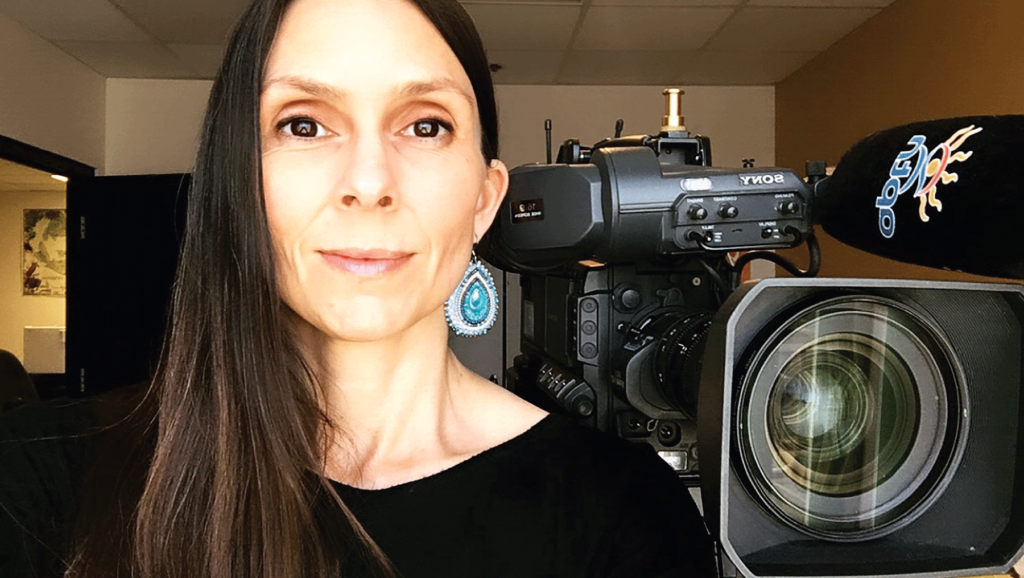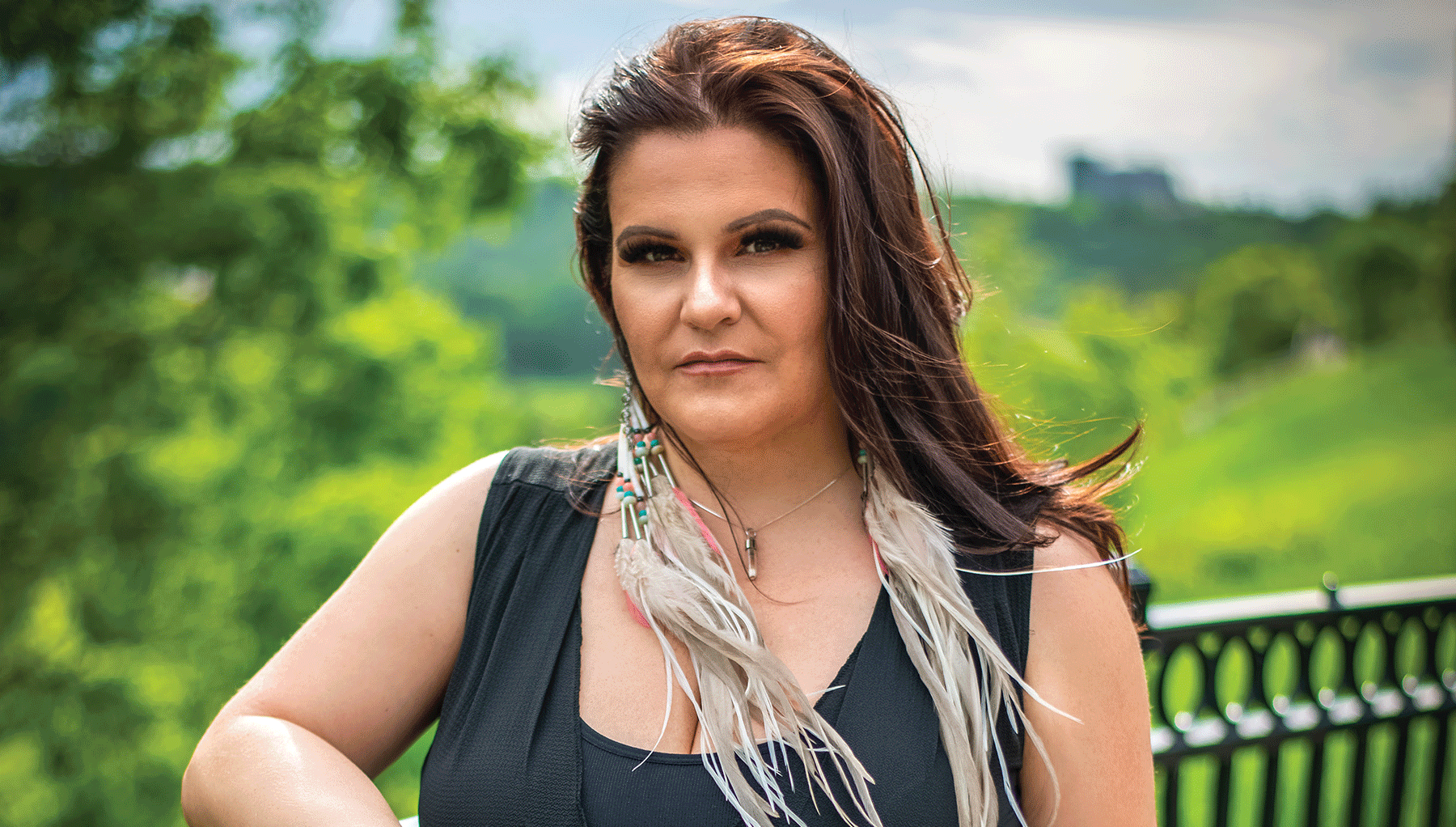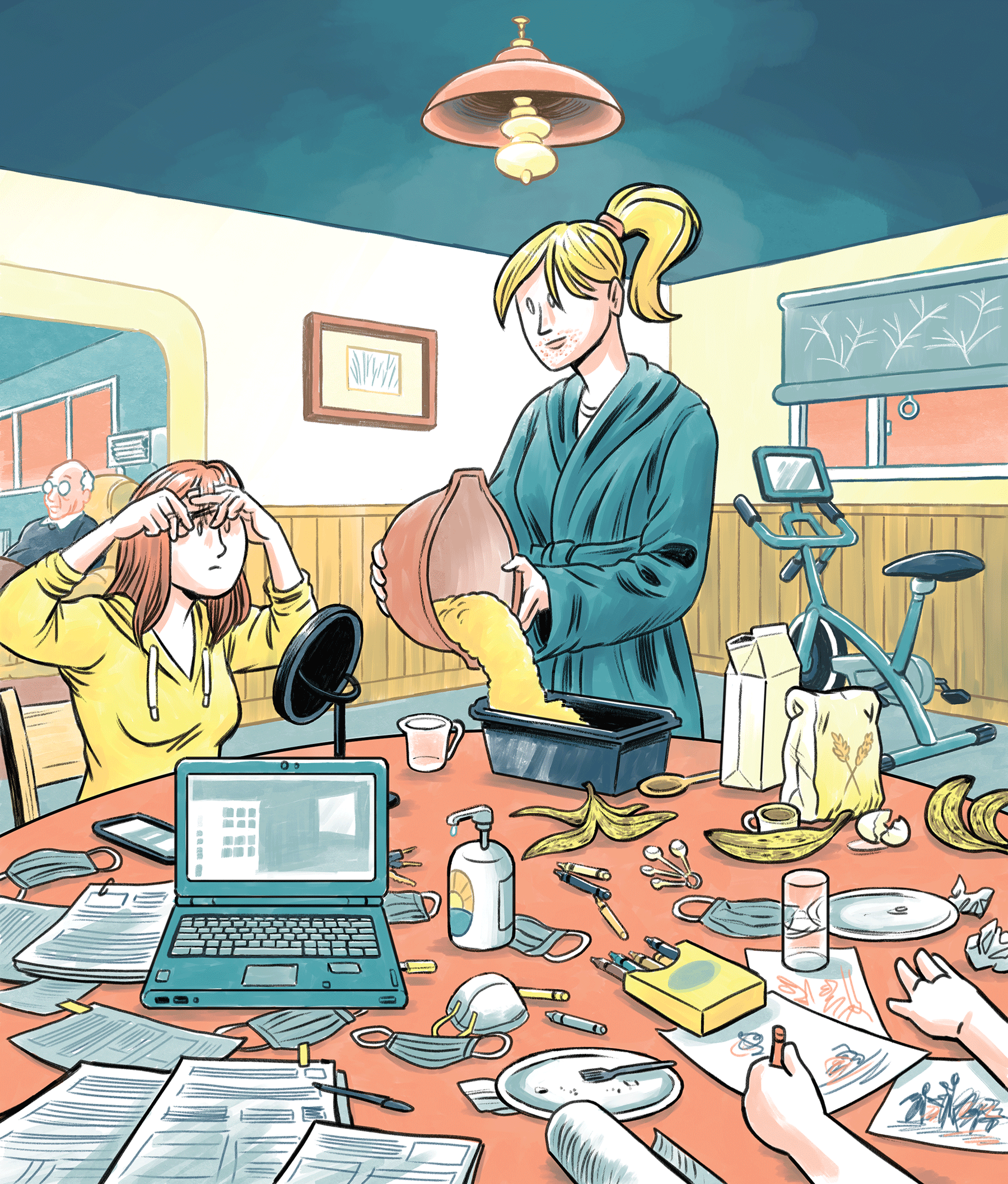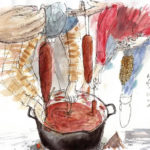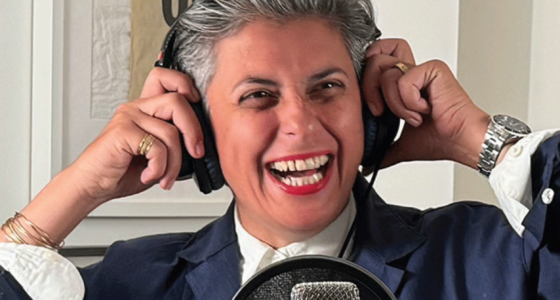On the ground improving coverage of communities that newsrooms have neglected, Indigenous journalists are telling their own stories.
Métis freelance journalist Brandi Morin arrived with her husband and two-year-old daughter in Blue River, B.C., on July 24, 2020, to cover a counter-protest the next day against a group of Indigenous land defenders. Located 230 kilometres north of Kamloops, Blue River, with a year-round population of around 200, is part of a vast territory inhabited by the Secwépemc People and was established as a crucial point for fur trading by settlers in the 1800s. Surrounded by lush forests of verdant green cedar and spruce trees and often snow-capped peaks, it’s since evolved into an important pit stop for the logging and tourism industries. Morin was one of the rare visitors who wasn’t a traveller or an ambitious hiker.
Tiny House Warriors, a Secwépemc land defenders group, had been occupying a piece of their traditional lands nearby that was to be cleared for the Trans Mountain pipeline expansion. Only a few months before Morin arrived in Blue River, the construction of the Coastal Gaslink pipeline had ignited a lengthy standoff between Wet’suwet’en land defenders and the RCMP. Morin had been directed by her editor at Canada’s National Observer to cover a counter-protest organized by townspeople and supporters of the pipeline.
“There wasn’t any other media there besides me,” remembers Morin, whose coverage of violence against Indigenous women, the disproportionate effect of COVID-19 on Indigenous communities, and Canada’s feeble attempts at reconciliation for various outlets—including CBC, Al Jazeera, the Toronto Star, and, before it folded, Huffington Post—has netted her over 10,000 followers on Twitter.
No violence broke out between the two groups but counter-protestors hurled racist insults at the land defenders while Morin was reporting.
As the sun set, she took a drive with Judy Wilson, elected chief of Neskonlith First Nation, who told her that in 2018 she had travelled to Houston, Texas, for the annual general meeting at Kinder Morgan, the company that initially set about constructing the pipeline. At the meeting, she told the company that the project would infringe on the Secwépemc People’s land rights. Wilson told Morin that Kinder Morgan’s executive chairman Richard Kinder was visibly upset at the scene.
As Morin returned to the hotel where she was staying with her daughter and husband, she received a notification from Periscope—a video-streaming app Morin had used covering the protest—alerting her that she had gained a verified follower: the Integrated Homicide Investigations Team, a unit of the RCMP responsible for investigating missing persons cases and suspicious deaths in lower B.C.
Morin says she recalled some of the families of missing and murdered Indigenous women she’d interviewed telling her they believed that RCMP officers were involved in the disappearances of their loved ones. Land defenders Morin had spoken to were convinced that the RCMP was surveilling them, a tactic often applied disproportionately against Indigenous activists by the Canadian government. Morin, who has written at length about state-sanctioned violence aimed at Indigenous people, felt uneasy. Blue River is only about a four-hour drive from the infamous “Highway of Tears,” where dozens of Indigenous women have gone missing since 1969. Around the world, Indigenous journalists have been targeted and killed while covering environmental issues and land occupations.
“This is not worth your life or putting you in danger,” Morin recalls her editor telling her as she barricaded the doors to her room
Confused as to why an RCMP homicide unit had followed her on Periscope in the middle of the night, Morin checked who else the account was following. The only other verified account was that of the Houston Police Department. Her mind went into overdrive: “I’m a journalist, I’m female, I’m far from home, and I am at risk because I’m Indigenous.”
Morin went to Chief Wilson, who was staying just a few doors down from her at the same hotel, to ask her advice. “Oh, yeah, they’re trying to intimidate you,” Wilson told her. Morin felt the blood drain from her face as she rushed back to her room to call her editor. “This is not worth your life or putting you in danger,” Morin recalls her editor telling her as she barricaded the doors to her room and shut the blinds.
While Morin had planned to stay in Blue River for a couple more days, she left the next morning. “I’m not sure if it’s the same for a non-Indigenous journalist, but if you’re an Indigenous journalist on the job, there’s fear there,” she says.
For Indigenous journalists, and especially women, fear of police intimidation is just one of the common risks associated with trying to report the news. In a 2020 report titled “Half of the Story Is Never Enough,” women journalists, including 15 Indigenous women, detailed stories of workplace bullying and harassment, systemic racism in newsrooms, and a lack of mental health support when covering especially distressing stories. Morin was also featured in the report. Published by Journalists for Human Rights, the report was released at a critical moment for Canadian journalism, as widespread protests against police brutality forced a reckoning with the racism that permeates the industry.
Simultaneously, more and more Indigenous reporters have found success telling stories on their own terms that are often misunderstood or ignored by predominantly white Canadian media.
Karl Dockstader is Oneida from Oneida of the Thames near London, Ont., and is one of the handful of journalists who have been arrested covering Indigenous land disputes in Canada.
Co-founder of the One Dish, One Mic podcast with Sean Vanderklis, he, like Vanderklis, is open about the fact that he doesn’t have a background in journalism or broadcast media. Vanderklis, who is Mississauga from the Curve Lake First Nation, has been involved with various not-for-profit organizations over the years that offer programs for Indigenous communities around Niagara, Ont., including the Niagara Regional Native Centre, which Dockstader now heads as executive director. One Dish, One Mic was originally started in March of 2016 as a podcast exploring Indigenous stories from an educational perspective, before pivoting to a weekly broadcast on CKTB out of Niagara. The original idea of starting a podcast had been brought to the two of them when they were mere acquaintances. Vanderklis says the program pivoted to a more journalistic style when he made a last-minute application for a fellowship offered by CBC.
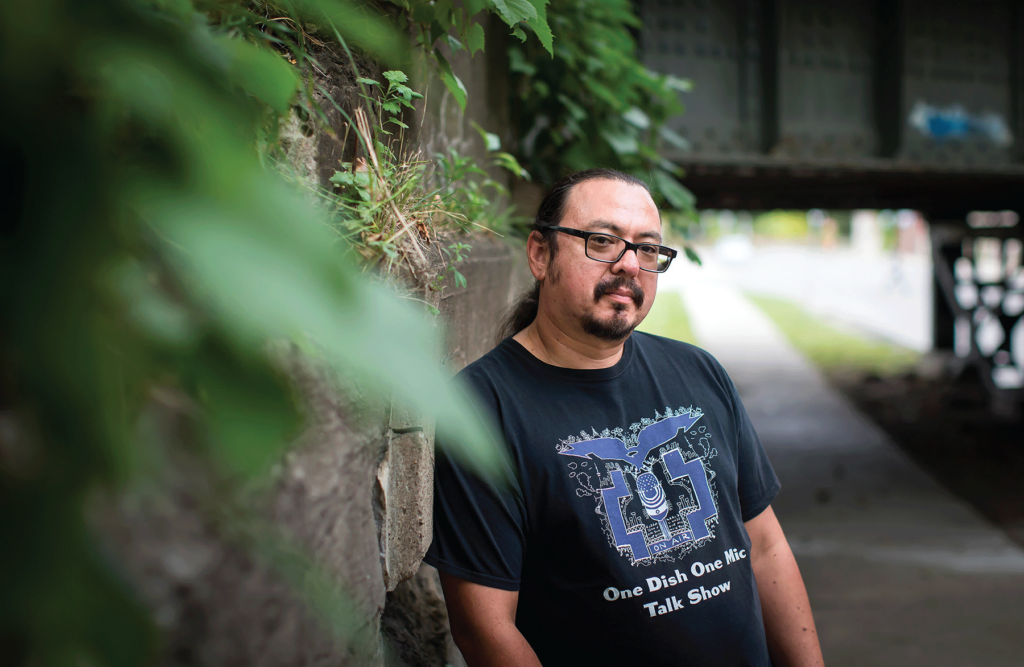
“I think it’s fair to say we weren’t really journalists before that,” he says. “We’ve shifted our perspective a bit and shifted how we’re covering stories.”
While the pair have reported on a range of issues, including the impact of the Sixties Scoop, the shooting of Colten Boushie, and the opioid epidemic in Niagara, they spent a substantial amount of airtime in 2020 on the land reclamation campaign undertaken by Indigenous land defenders just outside of Caledonia, Ont.
The standoff between Indigenous land defenders and Ontario Provincial Police formally began in late July, as defenders began occupying the site of a planned housing development on the outskirts of Caledonia to halt construction. While the developers of the site, Foxgate Developments, had been given approval by the Six Nations of Grand River council to erect a housing complex, the land defenders have said there was little to no consultation with residents on the reserve.
Since moving onto the site, the land defenders have dealt with arrests and raids by Ontario Provincial Police and have been labeled “terrorists” by Haldimand County’s police services board.
Dockstader and Vanderklis began to cover the standoff at 1492 Land Back Lane just days after it began, before it drew attention from other journalists.
“Journalists aren’t making a meaningful attempt to get in contact with people,” said Vanderklis on a Canadaland podcast episode released in August of 2020, adding “Karl and I have been there since day one.”
Dockstader remembers chatting with another reporter who was incredulous that he had managed to stay on the site for over a week. “Non-Indigenous media doesn’t really bother to invest time into the community,” says Dockstader. “They don’t wanna bother to build the equity that I think you need to build in Indigenous communities before you can properly report on them.”
Dockstader says that he and Vanderklis try their best to avoid the more exploitative aspects of journalism when they’re reporting. “We think that it’s important when you’re telling people’s stories, that those people have some say in how their story is told,” he says. “That’s how you get away from the trauma porn and the poverty porn and the rez porn.”
In September, Dockstader was arrested by Ontario Provincial Police. While anyone is potentially at risk of being arrested as long as there is an injunction on the site, Dockstader was sure his status as a journalist would protect him. He says that what surprised him most was how other journalists covered his arrest: according to Dockstader, other journalists didn’t use it as a means of focusing on broader repression of Indigenous stories by police. “Beyond my story, I’m surprised there wasn’t more interest in the underlying story,” he says.
Dockstader is just one of the journalists who has been arrested while covering Indigenous land reclamations, however. Justin Brake was arrested at Muskrat Falls, N.L., while covering the protest of a hydroelectric dam by Indigenous activists for The Independent in 2016—appeal court justices in Newfoundland and Labrador later reversed his conviction. Filmmaker Melissa Cox was arrested by the RCMP while she was covering rail blockades protesting the construction of the Coastal Gaslink pipeline through Wet’suwet’en territory in British Columbia in early 2020. Meanwhile, Starla Meyer—a journalist with the Indigenous-run news website Real People’s Media—was arrested by Ontario Provincial Police for covering the Caledonia land dispute just two weeks after Dockstader’s own arrest. “The OPP has made clear that it is undertaking a concerted attempt to silence grassroots Indigenous journalists as it enables an agenda of illegal land sales by the Provincial and Federal government,” Meyer said in a statement after the arrest.
“The concept of having a free press in Canada is very one-sided,” says Vanderklis. “If you’re a cis white male, that protection exists but the moment you cross that line and start covering Indigenous-led events, that protection seems to go through the window.”
As the lack of representation of Black and Indigenous voices in the news has increasingly come under scrutiny, there has been a litany of rallying cries from editors, reporters, columnists, and readers for the industry to do a better job covering marginalized communities. In 2015, Toronto Star public editor Kathy English acknowledged the media’s failure to report on Indigenous peoples and her own ignorance of Canada’s legacy of injustice. Last June, the head of Journalists for Human Rights, Rachel Pulfer, and Native Women’s Resource Centre board member Megan Fowler published an opinion piece in The Globe and Mail calling for newsrooms to hire more Indigenous reporters.
Morin herself asked, “Why is Canada still shutting out Indigenous voices?” in a piece for Elle Canada that same month. “The revolution happening around justice reform is long overdue,” she wrote. “But if we are going to work towards truly uprooting systemic racism, the media, which plays a huge role in documenting and influencing this revolution, must be held to account as well.”
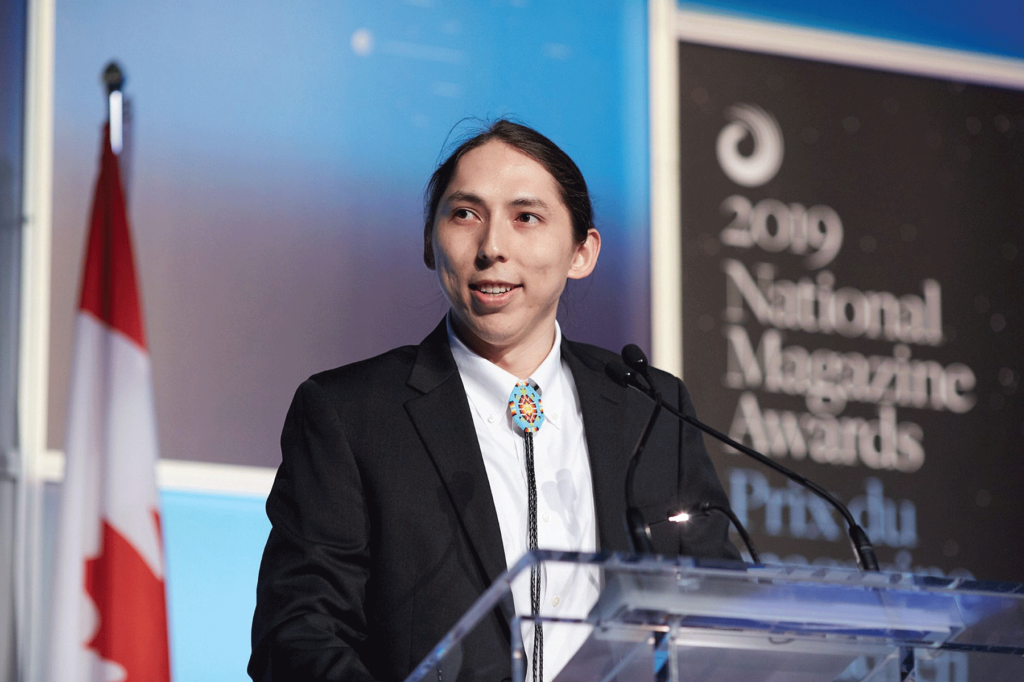
For years, Canada’s media has been overwhelmingly white and there is a notorious resistance across the industry to self-reporting on diversity statistics in the newsroom. A 2010 study examining leadership at Canada’s largest media companies—including CBC Radio Canada, Torstar and Rogers—found that less than five percent of leadership roles were filled by visible minorities. A 2019 study of columnists at Canada’s three largest publications, the Toronto Star, The Globe and Mail, and the National Post, found that over a 21-year-period, none of them had an Indigenous columnist who wrote regularly.
“A part of me was tired of being the only native journalist everywhere I was,” says Kyle Edwards, a former staff writer at Maclean’s. “Whether it was ProPublica or Maclean’s or the Toronto Star, I always found it very awkward talking about these issues with people who were more or less indifferent about them.”
Edwards, who is Anishinaabe from the Lake Manitoba First Nation, completed his bachelor’s degree in journalism at Ryerson University in 2017. Since then, he’s covered the disproportionate number of First Nations children in foster care and earned the JHR/CAJ Emerging Indigenous Journalist Award for his coverage of several stories, including the water crisis in Neskantaga First Nation.
“To truly uproot systemic racism, the media, which plays a huge role in documenting this revolution, must be held to account as well”
Even for successful young Indigenous journalists like Edwards, who manage to make it into legacy newsrooms, editors and colleagues can present a host of difficulties. For Edwards, one of the most frustrating aspects of working in a mainstream newsroom was editors’ lack of interest in positive depictions of Indigenous life. He says that portrayals of cultural revitalization and ceremony were often seen as less newsworthy than stories that dealt with trauma or violence. “I think seeing good things happening is crucial, because for so long native communities were seen as poverty-stricken, poor communities,” he says. “But if you pitched a happy story, those weren’t necessarily treated with the same kind of enthusiasm.” Now working out of Palo Alto, Calif., as the first managing editor at Native News Online, Edwards says he is intrigued by the opportunity to look at Indigenous stories from a different perspective than what legacy media is doing.
Founded a decade ago by Levi Rickert from the Potawatomi Nation, Native News Online has steadily grown to cover issues facing disparate Indigenous communities across the United States and has managed to carve out a considerable following. Rickert had virtually no journalism experience when the website launched in 2011 and largely ran it as a one-man operation for nearly a decade, spending years criss-crossing the United States to report from reservations and protests prior to hiring Edwards in the spring of 2020.
Although Edwards managed to find an Indigenous-led newsroom to call home, those kinds of opportunities can be severely limited for young reporters. As a result, some Indigenous journalists can give up on the industry entirely.
Waubgeshig Rice, who is an Anishinaabe author and freelance journalist from Wasauksing First Nation in southern Ontario, remembers seeing many of his Indigenous colleagues quickly grow disillusioned as their efforts to cover Indigenous issues were impeded by uninterested editors. “Over the years I saw so many talented people just give up,” he says. “They were frustrated and fed up with the barriers they came up against.”
Rice recalls that it was a common occurrence for editors to be generally unaware of the impact of colonialism, residential schools, or the Sixties Scoop on Indigenous communities when being pitched to by reporters. “There wasn’t the capacity to understand those issues and to adequately report on them,” he says.
In a 2020 piece for The Walrus titled “Letter to a Young Indigenous Journalist,” Rice encouraged reporters attempting to break into the industry to persevere even with the myriad barriers that continue to permeate Canadian newsrooms.
“I believe the future of Canadian journalism will be better for people like you,” he says in the letter. “No matter what happens in your pursuit of a career in journalism, you’ll always have your community.”
Rice recalls it was common for editors to be generally unaware of the impact of colonialism, residential schools, or the Sixties Scoop
Along with 1492 Land Back Lane, one of the most recent examples of the stark contrast in coverage between Indigenous-run media and legacy media was the eruption of violence directed at Indigenous fishers on the East Coast in 2020.
“It’s a story I’ve spent a lot of time on,” said APTN producer Trina Roache in an interview with CBC Mainstreet host Jeff Douglas. “Sometimes when I read the headlines and when I see the mainstream coverage, it’s frustrating because there’s an imbalance sometimes or a language that happens in the coverage that to me creates a narrative that the Mi’kmaq are doing something wrong, which isn’t the case.”
Karyn Pugliese, assistant professor at the Ryerson School of Journalism, a former news director at APTN and the former president of the Canadian Association of Journalists, says that even as violence toward Indigenous fishermen escalated further, journalists continued to frame the situation as a “dispute” or merely an instance of rising tensions between both parties. “They’re using language that makes it sound like it’s two ways, but it’s one way,” she says.
Anti-Indigenous violence flared in mid-September when the Sipekne’katik First Nations opened a mid-sized fishery in western Nova Scotia, which commercial fishers claimed infringes on provincial rules allowing lobster trapping only between May and November. Fishers quickly began vandalizing equipment, harassing Mi’kmaw fishers, and removing lobster traps belonging to the Indigenous-owned fishery. Tension between non-Indigenous and Indigenous fishers dates back to the 1990s. Mi’kmaw fishers can legally fish lobster year round as a treaty right, but the reality is different due to competing interpretations of what constitutes a “moderate livelihood” through fishing.
A citizen of the Pikwàkanagàn First Nation in northeast Ontario, Pugliese says that journalists covering the violence would regularly quote commercial fishermen’s false assertions that the Sipekne’katik fishery was illegal. “That was a case of poor journalism,” she says. “They weren’t asking the critical questions in the way they should be asking them and they’re reporting things that are just blatantly not true.”
Roache, a reporter who has covered Indigenous communities on the East Coast since the early 2000s, says that mainstream media still struggles to contextualize the role that colonialism plays in conflict like that in Saulnierville, N.S. “A lot of that context and history is really important as a foundation to the story,” she says. “But sometimes that’s missing or was a little line at the bottom of a story when it really should be much higher up.”
Roache started her career with CBC before transferring to APTN, which was established as an outlet for Indigenous journalists to report on their own communities. Founded first in the north in 1992, APTN got a national broadcasting license in 1999 after a report from the Canadian Radio-television and Telecommunications Commission suggested that a nationally broadcast Indigenous channel would assist in the preservation of Indigenous languages and culture.
Roache says that, although she enjoyed her time at the CBC, she couldn’t resist the opportunity to cover Indigenous stories on her own terms. “This sounds like an amazing opportunity to be able to get into these communities and tell stories,” she remembers thinking at the time.
She adds that journalism programs at post-secondary institutions in Canada are also due for self-reflection on how they treat aspiring Indigenous reporters. A graduate of the program at University of King’s College in Halifax, Roache says that ideas of objectivity and neutrality that are so heavily emphasized in journalism schools often disguise a bias against Indigenous voices: “When you’re looking at Indigenous rights, the bias is that there’s a legitimacy to the Canadian perspective but not the Indigenous perspective.”
For Brandi Morin, the relationship between Indigenous communities and mainstream media is fundamentally broken, and it’s not helped by the fact that coverage of Indigenous communities is still largely told from white perspectives. “There has to be an effort for legacy media to go into the trenches of the Indigenous world,” she says. “The context and history behind our stories is so crucial, because without those things, it just reinforces stereotypes and discrimination and misunderstanding.”
Even with the challenges that Indigenous journalists face, Morin says that a combination of journalists working within mainstream media and freelancers like herself forging their own path is key to telling their stories. “What the media does is it shapes the thoughts and opinions of people, it helps to change laws and transform communities,” she says. “This work is so incredibly important even if it has to go to outside media to get there.”
While police across the country intimidate journalists covering Indigenous stories and legacy media make half-hearted calls for more diverse newsrooms, Morin says journalists like her aren’t going anywhere.
“It’s so important to be getting our stories out there,” she says. “We’re trying to create a different way of storytelling.”
